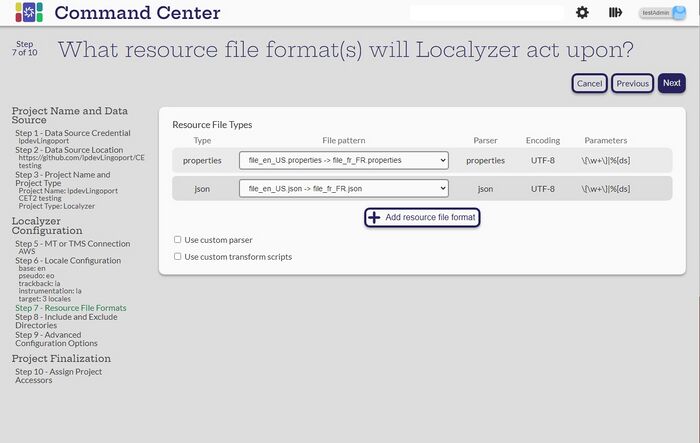Difference between revisions of "Resource File(s) Format"
| Line 7: | Line 7: | ||
If the base resource file is <code>resource_en_US.properties</code> then the file pattern should be <code>file_en_US.properties -> file_fr_FR.properties</code>. |
If the base resource file is <code>resource_en_US.properties</code> then the file pattern should be <code>file_en_US.properties -> file_fr_FR.properties</code>. |
||
| − | * Select '''Use custom parser''' or '''Use custom transform scripts''' if there are already appropriate files defined in the Setting -> |
+ | * Select '''Use custom parser''' or '''Use custom transform scripts''' if there are already appropriate files defined in the '''Setting -> System Files -> XML Parser Files''' or '''Transform Folders''' |
Select '''Next''' |
Select '''Next''' |
||
Revision as of 16:58, 1 September 2023
- Select the Resource File Types that are to be translated. Verify that the file pattern is correct.
For example if the base resource file is resource.properties, then the file pattern should be file.properties -> file_fr_FR.properties.
If the base resource file is resource_en_US.properties then the file pattern should be file_en_US.properties -> file_fr_FR.properties.
- Select Use custom parser or Use custom transform scripts if there are already appropriate files defined in the Setting -> System Files -> XML Parser Files or Transform Folders
Select Next
Step 8: Set up optional include or exclude patterns
Step 1:Data Source Credential for the project
Creating a Globalyzer Project - Step 4: Globayzer Lite Definition File
Creating a Localyzer Project - Step 5: Which MT or TMS will Localyzer use
Step 6: What are the locales Localyzer is acting on?
Step 8: Set up optional include or exclude patterns
Step 9: Optional Advanced Localyzer Settings
Step 10: Grant Users and Teams Access
